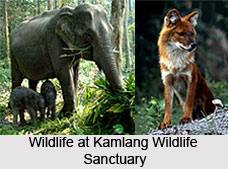 Kamlang Wildlife Sanctuary is located in the south eastern region of Lohit district in the Indian state Arunachal Pradesh. It derives its name from River Kamlang that meanders through the sanctuary and ultimately flows into Brahmaputra River. Kamlang Wildlife Sanctuary is spread between the famed Namdapha National Park, on its south, and Lang River on its north. The western border of the sanctuary is formed by Lati River while its eastern part is bordered by Tawe River. The place is adorned with unmatched natural beauty featuring perennial water sources, beautiful terrains and mesmerizing landscapes. Government of Arunachal Pradesh had put much effort to develop the area as an inviting tourist spot. The terrain of the sanctuary is quite high and difficult which makes several regions quite inaccessible.
Kamlang Wildlife Sanctuary is located in the south eastern region of Lohit district in the Indian state Arunachal Pradesh. It derives its name from River Kamlang that meanders through the sanctuary and ultimately flows into Brahmaputra River. Kamlang Wildlife Sanctuary is spread between the famed Namdapha National Park, on its south, and Lang River on its north. The western border of the sanctuary is formed by Lati River while its eastern part is bordered by Tawe River. The place is adorned with unmatched natural beauty featuring perennial water sources, beautiful terrains and mesmerizing landscapes. Government of Arunachal Pradesh had put much effort to develop the area as an inviting tourist spot. The terrain of the sanctuary is quite high and difficult which makes several regions quite inaccessible.
Glow Lake in Kamlang Wildlife Sanctuary
Kamlang Wildlife Sanctuary also hosts a few water bodies among which Glow Lake is a significant one having a circumference of about 4 to 5 kilometres. It is a large mountain lake situated at an elevation of 1300 metres and is extensively visited by beautiful migratory birds during winter. Hoolock Gibbons, Tigers and Elephants also use the Glow Lake, as a water resource.
Flora of Kamlang Wildlife Sanctuary
 Kamlang Wildlife Sanctuary enjoys a sub-tropical climate as it falls within the sub tropical zone. The vegetation of the forest can be categorized into alpine forests and tropical temperate. The lower reaches and foothills of the region are covered with tropical wet evergreen forests while the alpine vegetation dominates the higher altitudes encompassing Daphabhum peak, bordering Namdapha National Park. Common species of trees in the sanctuary constitutes about 150 in number and include Ammora wallichi (Amari), Gmelina arborea (Gamari), Terminalia chebula (Hillika), Canarium resigniferum (Dhuna) and many others.
Kamlang Wildlife Sanctuary enjoys a sub-tropical climate as it falls within the sub tropical zone. The vegetation of the forest can be categorized into alpine forests and tropical temperate. The lower reaches and foothills of the region are covered with tropical wet evergreen forests while the alpine vegetation dominates the higher altitudes encompassing Daphabhum peak, bordering Namdapha National Park. Common species of trees in the sanctuary constitutes about 150 in number and include Ammora wallichi (Amari), Gmelina arborea (Gamari), Terminalia chebula (Hillika), Canarium resigniferum (Dhuna) and many others.
Fauna of Kamlang Wildlife Sanctuary
Kamlang Wildlife Sanctuary shelters a vast variety of fauna. 105 species of birds and 61 species of mammals have been identified here. All four big cats including Snow Leopard, Clouded Leopard, Leopard and Tiger are the common inhabitants. Certain endangered species such as Himalayan Palm Civets, Leopard Cat, Slow Lories and Hoolock Gibbon can also be spotted in the sanctuary. Other species commonly found here are Giant and Flying Squirrels, Hornbills, Deer, Civets, Boar, Capped Langur, Stump Tailed Macaque etc.
Visiting Information
Kamlang Wildlife Sanctuary can be reached through Namsai Wakro road form Wakro which is small town and circle headquarter under Namsai Sub-Division. It is located at a distance of 70 kilometres from Namsai town. Tinsukia is the nearest railway station while Dibrugarh is the nearest airport for reaching the sanctuary.



















